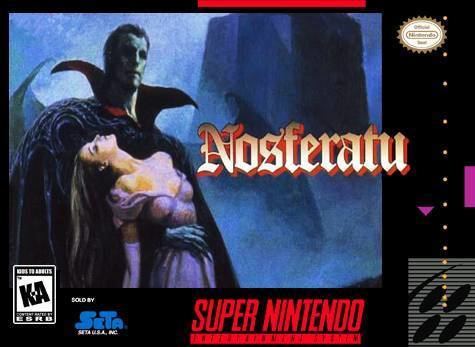Composer(s) Masanao Akahori | Initial release date 7 October 1994 | |
 | ||
Programmer(s) T. NakamuraHiroki AzumadaYoshihiro AndoTetsuo Mochizuki Artist(s) Kōji IsodaKōzō IgarashiShingo Aoyama Similar SETA Corporation games, Platform games | ||
Nosferatu (ノスフェラトゥ) is an action platform game developed and published by SETA Corporation for the Super Nintendo Entertainment System. It was released in Japan on October 7, 1994, and in North America in October 1995.
Contents
The player controls a young man known as Kyle, who rides to the vampire Nosferatu's castle in order to defeat him and save his beloved girlfriend Erin from his clutches.
Story
The game follows the story of a young man named Kyle who has his girlfriend Erin sequestered with the vampire Nosferatu; he has the objective of obtaining their blood. Kyle then goes up to the castle where Nosferatu lurks with intent to rescue Erin, but getting there, he discovers that the huge place is full of traps and violent creatures.
The game starts with Kyle being trapped in the dungeon of the castle, the player must escape from there and walk through the castle until they reach the tower where Erin and Nosferatu are.
Gameplay
The game is played like Prince of Persia, however the player fights with his bare fists. Despite that, they can use many unique moves and special combos with attacking. He fights various monsters such as Frankenstein monsters, zombies, gargoyles and ghosts. The bosses are the Werewolf, and Beast Men, amongst others. There are three types of crystals used in the game in addition to hourglass. Finding an hourglass extends the in-game time. Each crystal has its own unique abilities: red crystals give players a power up at every three crystals, green crystals recover the health of the player while the blue crystal extends the player's health bar.
Development and release
Nosferatu was programmed by T. Nakamura, Hiroki Azumada, Yoshihiro Ando and Tetsuo Mochizuki. Kōji Isoda, Kōzō Igarashi and Shingo Aoyama were served as graphic designers. Opus Corp handled the audio for the game, with Masanao Akahori composed the music, and Jun Enoki created the sound effects. Nosferatu was released by SETA Corporation on October 7, 1994, in Japan. This was followed by its North American release in October 1995.
Reception
GamePro judged the game to be a frustratingly difficult but still worthwhile cinematic platformer. They elaborated that the game is frustrating due to the sometimes slow character movements and lack of any password or save function, and that the strong atmosphere and slow-paced, strategic approach are its strong points. Brett Alan Weiss of AllGame praised Nosferatu's graphics and audio, making the game "imbued with cinematic style and flair", but criticized its controls. Weiss also derided the game's combat, which he considered "redundant and largely unexciting".
